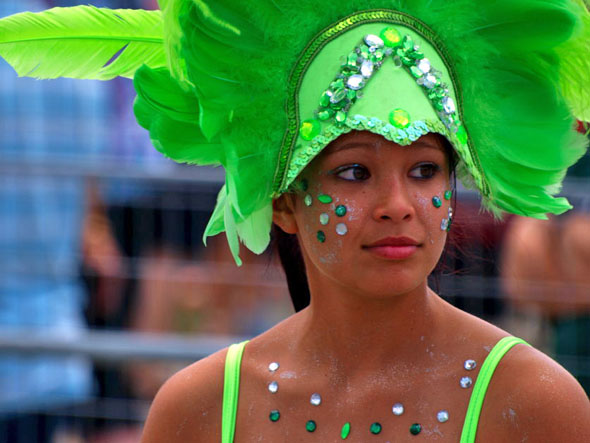
Caribana was the toast of Toronto this week, and I was pleased to see Eye run an article on the Caribana art exhibit at the Royal Ontario Museum. Critical discussion of this exhibition is long overdue—even if Eye ultimately shies away from the toughest issues it presents.
Basically, I went to last year's Caribana exhibit at the ROM and found it a bit of a troubling experience.
What this exhibit felt like to me—despite my fervent desire to see more artists of colour in our cultural institutions—was a cheap-and-dirty way for the ROM to draw a bit of Caribana's considerable audience, as well as to argue something along the lines of "Look! We are actually reflecting the diversity of Ontario."
To my mind, if the ROM was serious about honoring and including the traditions of Caribana and its communities, they would do an exhibition on the most stunning, virtuosic and culturally entrenched of Caribana's art forms—costume design, dance and music. The museum wouldn't focus on an cultural form—drawing and painting—that, despite the related virtuosity many artists of colour possess, has merely a marginal presence in Caribana and its communities. (This is particularly arguable in light of the fact that the ROM is a general historical and cultural museum, not an art gallery.)
So here's where that cheapness comes in: To do an exhibition on these central cultural forms of Caribana (and, by extension, of Caribbean communities in Ontario) would take a lot of primary research (or research collaboration) to get right—in other words, lots of organizational and curatorial-spending dollars to consult with musicologists, textile historians, dance experts and community representatives. A show on costume, music and dance would also take a lot more installation-design investment in the form of vitrines, speakers, TVs, platforms, mannequins and so on.
The current Caribana exhibition formula, in contrast, calls on the ROM to pay just one curator—artist Joan Butterfield, whose intentions I suspect are actually quite fine ones—and install mainly paintings in a quick, low-cost, around-the-room-at-eye-level format.
What ends up being sad about this exhibition formula (both in principle and in practice) is that it does little to reflect the vibrancy and reality of Caribbean culture and community in Ontario—while purporting to do just that.
Lowering the bar further, as Eye notes, is confusion encouraged by this exhibit around the complexities of Caribbean culture. The exhibition is actually co-presented by, as Eye reports, "The Association of African-Canadian Artists, whose main goal is to “introduce [African-Canadian] art into the mainstream Canadian market.”" Whether this can thereby qualify as specifically Caribbean-related art is therefore quite debatable.
Where Eye falls down is identifying a problem that it is capable of responding to, but doesn't: "While the exhibit has received much positive press, there have yet to be any reviews." Though I sometimes quibble with Eye arts editor David Balzer's critical judgments, he is, overall, a pretty ace viz-art reviewer. The fact that he chose for Eye to cover this exhibition with a question-posing feature written by a general freelancer, Rea McNamara—rather than delve critically into it himself—is telling of the difficult morass of issues that the ROM and this exhibit disappoint on overall.
Of course, I feel no small degree of trepidation in broaching these issues (at Eye's prompting) myself. I hope I have been able to underline that while I'm very supportive of seeing more artists and communities of colour reflected our cultural institutions, the doublespeak, obfuscation and institutional laziness surrounding this exhibition is a really bad means by which to go about achieving that goal.
What do you think?
Image by Gadjo Sevilla from BlogTO
Monday, August 3, 2009
The Royal Ontario Museum and Caribana: A Lost Opportunity?
Labels:
caribana,
royal ontario museum
Subscribe to:
Post Comments (Atom)

2 comments:
Haven't seen the ROM show, so I can't add to the conversation. However, I do hope you and others come to the AGO panel discussion around debates over identity politics in the Remix show. This is only tangentially relevant to your post, but you do point to Milroy's debate within the constellation of your disagreements with Balzer, and this could be a fruitful place to consider a lot of the baggage surrounding identity politics and major institutions. Here's the link for those interested:
http://www.ago.net/are-we-past-the-age-of-an-aboriginal-art-show
Hi Nick,
Thanks for your thoughts.
I do think that Remix panel will be interesting, as I indicated on Twitter last week.
Unfortunately, I will be out of town at that time (Aug 23) You'll have to take some notes for me!
As for identity politics issues, I actually feel they're tangential to my critique of this exhibition.
The ROM, again, is not an art gallery but a general historical/cultural museum. As such, I wish they would treat Ontario's communities with a serious cultural/historical exploration, rather than a "checklist style" approach.
I suspect it all comes down to the almighty budget lines and lack of cash flow, but I would just say do it better than this, or don't do it at all.
To my mind, Remix was a much stronger show overall, and is debatable, therefore, around different aesthetic-taste points. It was also contemporary art presented in the context of an art institution--not a general historical/cultural museum like the ROM.
Post a Comment